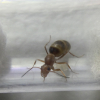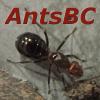Hi!
I've recently been seeing numerous arthropods within ant nests, ranging from the diminutive subterranean springtail to the fairly large Mymecophila cricket. After many months of table log and rock flipping, I noticed a trend: certain immature arthropods seem to live inside ant nests until they reach their later instars, despite the fact that those arthropods can survive fine on their own (I've given them the nickname "Pseudomymrecophiles"). Here's a short list:
Unidentified cockroach species nymphs: This species seems quite common in Citronella Lasius and Formica nests. Interestingly, some individuals tend to stay in the nest for their entire life. From what I've observed, they function as nest-cleaners (they eat the garbage from ant midden piles and nests).
Prickly Millipedes: I occasionally find tiny and prickly millipede species inside of Ponera and Aphaenogaster nests. This species is most likely a scavenger. Even though it purposefully nests with ants, it has several built-in defenses against them, such as porcupine-like quills (maybe toxic?). It stays in nests for at least its adult stage.
Springtails: Where I live, there are two dominant springtail species: the subterranean myrmecophile springtails and the giant gray springtails. The giant gray species actually sometimes nests in ant brood chambers as a juvenile. Sadly, though, this species is often targeted by ants by the time it reaches its final molt.
Isopod: Several juvenile individuals of sowbugs occasionally appear within ant nests. Rather than living permanently in the nest, they seem to travel in and out.
Field crickets: Tiny nymphs of this species sometimes hang around ant nests with large, empty corridors (like Formica nests). These crickets get no special protection from the ants, and I've seen many individuals hunted down by workers.
"Running" aphids: My backyard is populated by several colonies of Lasius flavus and Lasius claviger. Whenever I flip rocks with these species underneath, I often find aphids. Recently, I've been noticing a strange species of aphid within the nests. When they get uncovered, they often run away. The ants make no effort to pick up these aphids, and they often just watch them leave. This species is like the aphid version of the subterranean leafhoppers (the ones with the plumed tails).
Since I'm going to continue editing this list, feel free to bring up new finds!




















